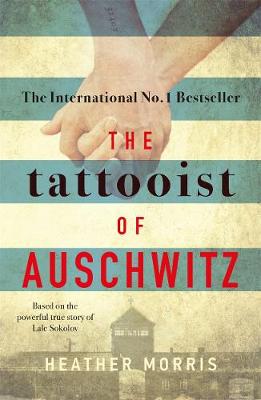
The Tattooist of Auschwitz is a poignant, fictionalized love sto-ry based on a true account. Ludwig “Lale” Eisenberg/Sokolovwas a Jewish Holocaust survivor who died in 2006. He met with the author over a three-year period to relate his story.
In 1943,Lale was 25 years old. Forced to go to the Auschwitz concentration camp, he resolved to survive. Because he spoke numerous languages, he was select-ed to be a”Tätowierer”(camp tattooist), tattooing se-rial numbers on new camp arrivals. Initially, he re-fused. However, another experienced tattooist urged him to reconsider since someone else would take the job and by doing this he may survive longer since tattooists received larger food rations, such as an ex-tra slice of bread. A courageous man of integrity and kindness, he risked his life, and used his position to exchange jewels and money from murdered Jews for food and medicine to keep fellow prisoners alive.
One of the new prison arrivals was a lovely young woman, Gita, with whom Lale fell in love at first sight. He vowed to survive so that he could protect and marry her. Imprisoned for over two and a half years, they were separated for a brief time, but miraculously reunited after leaving the camp. Lale told Gita: “I have been given the choice of participating in the destruction of our people, and I have chosen to do so in order to survive. I can only hope I am not one day judged a perpetrator or a collaborator.”
After Gita died in 2003, Lale wanted to tell their story to the world. He chose to wait until she died be-cause he worried he might be accused of being a collaborator with the SS, since technically, he’d worked for the SS, who had complete authority over all the concentration camps in Germany, as well as the occupied regions after 1934. The SS (Schutzstaffel, meaning “protection squadron”) was known as the parent organization of the Secret State Police, or Gestapo, and he didn’t want Gita to be affected by any accusations.
This moving book describes the German occupation in Europe during World War II and, despite the terror and deprivations that occurred, the humanity of the prisoners and others shines through

“[I]n a waking dream where the scent of a newly blown poppy is no longer a perfume but a blossoming; where the deep red of a maple leaf in autumn is no longer a colour but a grace; where a country is no longer a place but a lullaby. And also, where an outstretched hand is no longer a gesture but a moment of love, lasting until sleep, until waking, until everyday life.”
As in many books, the title is revealing. “Ru” loosely translated means a lullaby in Vietnamese and a stream or brook in French. The novel, a translation from the original French, is a series of vignettes that flow evocatively from Thúy’s reflections and retrospective musings about living in Vietnam and Canada and experiencing different cultures, all in an affecting, lyrical, non-linear manner.
The book, although categorized as fiction, is based on Thúy’s memories growing up in South Vietnam in a wealthy, well-educated family, then escaping to Canada to avoid political persecution after Communist North Vietnam invaded South Vietnam, living in refugee camps, and creating a new life in the West. She recounts how her family adapted to life in a foreign country and culture. She doesn’t complain, but merely provides observations.
The narrative includes only the bare essentials, each bursting with poetic prose and depth. The simplistic style belies the main themes of Ru, including:when contemplating on simplicity rather than the complex, it’s possible to perceive the true substance of nature and see beyond the superficialities in life; it’s important to look beyond appearances to find the real truth of a thing or person; and to be sensitive to the ephemeral beauty of nature and life.
On April 29, 1986, the largest library fire in the history of the U.S. (at the time) occurred in Los Angeles at the Los Angeles Public Library’s Central Library, destroying more than 400,000 books and damaging 700,000 with water and smoke. Many were irreplaceable.Built in 1926, the building had an outdated fire system with numerous fire code violations, including no sprinklers nor fire doors,blocked entrances, and cramped shelving with overstacked books. All contributed to the tragedy. The fire department determined the cause to be arson. However, the identity of the arsonist was never discovered. Only one suspect, part-time actor Harry Peak, was arrested, but never charged with the crime. Not only is this intriguing book about a search for an arsonist, it is an illuminating discussion about the sense of community libraries provide. I fondly recall, as many of you may, traveling to the children’s section of my local library with Mom each week eagerly selecting numerous books. As a native Angeleno, I also recall my dad discussing his excursions to Central Library. Journalist and author, Susan Orlean, also discusses the history of the Central Library, including some colorful past librarians, such as Mary Foy, who became city librarian in 1880 when women were not even permitted library cards. She was eventually fired because the library board decided her father could support her.Numerous anecdotes concerning libraries and books are also included throughout the book, such as:
Today, “the shipping department at Central Library moves 32,000 books around the city’s 72 branches five days a week.” Their annual budget is $172 million. (The Central Library is part of the L.A. Public Library system of the City of L.A., not to be confused with the L.A. County Library System which has 85 branches.)